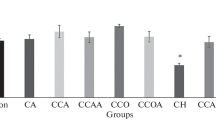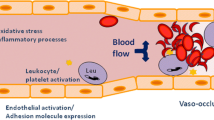Abstract
There is an increasing body of experimental studies demonstrating the toxic effects of oxygen-derived free radicals. Evidence supports an important role for free radicals in ischemic injuries, inflammation, and chemical-induced tissue injury. Free radicals are involved in normal biochemical processes like oxidative reduction and cellular metabolism; however, they also mediate disease processes. The participation of oxygen free radicals in lysis of red cells is important in some situations of intravascular hemolysis. This article will review neutrophil-derived oxygen free radicals, emphasizing: (1) their effects on the erythrocyte and (2) how these effects may be attenuated.
Similar content being viewed by others
References
R. B. Johnston, D. E. Lehmeyer and L. A. Guthrie,Generation of superoxide anion and chemiluminescence by human monocytes during phagocytosis and on contact with surface bound immunoglobulin G. J. Exp. Med.143, 1551–1556 (1976).
J. T. Curutte and B. M. Babior,Biological defense mechanisms: The effect of bacteria and serum on superoxide production by granulocytes. J. Clin. Invest.53, 1662–1672 (1974).
W. Pick and Y. Keisari,Superoxide anion and hydrogen peroxide production by chemically elicited peritoneal macrophages: Induction by multiple non-phagocytic stimuli. Cell. Immunol.59, 301–318 (1931).
L. R. DeChatelet, P. S. Shirley and R. B. Johnston,Effect of phorbol myristate acetate on the oxidative metabolism of human polymorphonuclear leukocytes. Blood47, 545–554 (1976).
R. K. Root and J. A. Metacalf,H 2O2 release from human granulocytes during phagocytosis: Relationship to superoxide anion formation and cellular catabolism of H2O2: Studies with normal and cytochalasin B-treated cells. J. Clin. Invest.60, 1266–1279 (1977).
B. D. Goldstein and O. J. Balchum,Effect of ozone on lipid peroxidation in the red blood cell. Proc. Soc. Exp. Biol. Med.126, 356 (1967).
E. L. Becker, M. Sigman and J. M. Oliver,Superoxide production induced in rabbit polymorphonuclear leukocytes by synthetic chemotactic peptides and A23187: The nature of the receptor and the requirements of Ca 2+. Am. J. Pathol.95, 81–98 (1979).
B. M. Baboir,Oxygen-dependent microbial killing by phagocytes. N. Engl. J. Med.298, 721–725 (1978).
J. M. McCord,Free radicals and inflammation: Protection of synovial fluid by superoxide dismutase. Science185, 529–531 (1974).
R. F. del Maestro and I. Alexander,Oxygen derived free radicals: Their role in inflammation. InThe inflammatory process. pp. 113–143 (P. Venge, A. Lindbom, Eds.). Almquist and Wiksell International, Stockholm, Sweden 1981.
S. J. Klebanoff,Oxygen metabolism and the toxic properties of phagocytes. Ann. Intern. Med.93, 480–490 (1980).
S. J. Klebanoff,Myeloperoxidase-halide-hydrogen peroxide antibacterial system. J. Bacteriol.95, 2131–3138 (1968).
A. A. Barber and F. Bernheim,Lipid peroxidation: Its measurement, occurrence and significance in animal tissues. Adv. Geront. Res.2, 355–404 (1967).
C. J. Dillard and A. L. Tappel,Fluorescent damage products of lipid peroxidation. InMethods in enzymology. Vol. 105, pp. 337–341 (L. Packer, Ed.). Academic Press, New York 1984.
B. L. Fletcher, C. J. Dillard and A. L. Tappel,Measurement of fluorescent lipid peroxidation products in biological systems and tissues. Anal. Biochem.52, 1–9 (1973).
C. J. Dillard and A. L. Tappel,Fluorescent products have reaction of peroxidizing polyunsaturated fatty acids with phosphatide ethanolamine and phenylalanine. Lipids8, 183–189 (1973).
A. L. Tappel,Measurement of and protection from in vivo lipid peroxidation. InFree radicals in biology. Vol. 4, pp. 1–47 (W. Pryor, Ed.). Academic Press, New York 1980.
E. N. Frankel,Lipid oxidation. Prog. Lipid. Res.19, 1–22 (1980).
E. W. Kellogg and T. Fridovich,Superoxide, hydrogen peroxide, and singlet oxygen in lipid peroxide by a xanthine oxidase system. J. Biol. Chem.250, 8812–8817 (1975).
J. M. C. Gutteridge,The protective action of superoxide dismutase on metal catalyzed peroxidation of phospholipids. Biochem. Biophys. Res. Comm.77, 379–386 (1977).
J. M. McCord,Free radicals and inflammation: Protection of synovial fluid by superoxide dismutase. Science185, 529–531 (1974).
R. A. Greenwald,Oxygen radicals and connective tissue. J. Rheumatol.8, 185–187 (1979).
R. A. Greenwald and W. W. May,Inhibition of collagen gelation by action of the superoxide radical. Arth. Rheumatol.22, 251–259 (1979).
W. S. Lin, D. A. Armstrong and M. Lal,Effects of superoxide dismutase dithiothreital and formate ion on the inactivation of papain by hydroxyl and superoxide radicals in aerated solutions. Int. J. Rad. Biol.33, 231–243 (1978).
F. Lavelle, A. M. Michelson and L. Dimitnijeur,Biological protection by superoxide dismutase. Biochem. Res. Comm.55, 350–357 (1973).
D. G. Wickens, T. L. Graff, J. Lunce and T. L. Dormandy,Free radical-mediated aggregation of human gamma globulin. Agents and Actions11, 650–651 (1981).
H. Carp and A. Janoff,In vitro suppression of serum elastase-inhibitory capacity by reactive oxygen species generated by phagocytosing polymorphonuclear leukocytes. J. Clin. Invest.63, 793–797 (1978).
R. A. Clark, S. Szat, K. Venkalasubvamanian and E. Schiffman,Chemotactic factor inactivation by myeloperoxidase-mediated oxidation of methionine. J. Immunol.124, 2020–2026 (1980).
S. J. Weiss,Neutrophil-generated hydroxyl radicals destroy RBC targets. Clin. Res.27, 466A (1979).
S. J. Klebanoff and R. A. Clark,Hemolysis and iodination of erythrocyte components by a myeloperoxidase-mediated system. Blood45, 699–707 (1975).
E. W. Kellogg and I. Fridovich,Liposome oxidation and erythrocyte lysis by enzymically generated superoxide and hydrogen peroxide. J. Biol. Chem.252, 6721–6728 (1977).
G. Bartosz, R. Fried, E. Grzelinska and W. Leyko,Effect of hyperoxide radical on bovine-erythrocyte membrane. Eur. J. Biochem.73, 261–264 (1977).
T. Sachs, C. F. Moldow, P. R. Craddock, J. K. Bowers and H. S. Jacob,Oxygen radical-mediated endothelial cell damage by complement-stimulated granulocytes: An in vitro model of immune vascular damage. J. Clin. Invest.61, 1161–1167 (1978).
R. H. Simon, C. H. Scroggin and D. Patterson,Hydrogen peroxide causes the fatal injury to human fibroblasts exposure to oxygen radicals. J. Biol. Chem.256, 7181–7186 (1981).
R. A. Clark and S. J. Klebanoff,Myeloperoxidase-mediated platelet release reaction. J. Clin. Invest.63, 177–183 (1979).
A. Slivka, A. F. Lobuglio and S. J. Weiss,A potential role for hypochlorous acid in granulocyte-mediated tumor cell cytotoxicity. Blood52 (2), 347–350 (1980).
R. A. Clark and S. J. Klebanoff,Neutrophil-mediated tumor cell cytotoxicity: Role of the peroxidase system. J. Exp. Med.141, 1442–1447 (1975).
D. C. Smith and S. J. Klebanoff,A uterine-mediated sperm inhibitory system. Biol. Repro.3, 229–235 (1970).
B. M. Babior,Oxidizing radicals and red cell destruction. InThe function of red bloods cells: Erythrocyte pathobiology. pp. 173–195 (E. F. H. Wallach, Ed.). Alan R. Liss, Inc., New York 1981.
H. S. Jacob and S. E. Lux,Degradation of membrane phospholipids and thiols in peroxide hemolysis: Studies in vitamin E deficiency. Blood32, 549–568 (1958).
A. Clark and N. H. Hunt,Evidence for reactive oxygen intermediates causing hemolysis and parasite death in malaria. Infect. and Immun.39, 1–6 (1983).
A. Tomoda, H. Suzuki, Y. Fukuhara, Y. Ueda, K. Niho, Y. Yoneyama and K. Kakinuma,Involvement in active oxygens released by activated leukocytes in hemolytic mechanisms of G6PD deficient red cells. Acta Haematol. Jpn.47, 189–194 (1981).
W. B. Gratzer,The red cell membrane and its cytoskeleton, J. Biochem.198, 1–8 (1981).
S. K. Gain and S. B. Shohet,Calcium potentiates the peroxidation of erythrocyte membrane lipids. Biochem. Biophys. Acta.642, 46–54 (1981).
D. Chiu, B. Lubin and S. B. Shohet,Peroxidative reactions in red cell biology. InFree radicals in biology. Vol. 5, pp. 115–160 (W. A. Pryor, Ed.). Academic Press, New York 1982.
W. A. Pryor,Free radical reactions in biological systems. InFree radicals in biology. Vol. IV, pp. 1–47 (W. A. Pryor, Ed.). Academic Press, New York 1976.
A. L. Tappel,The mechanism of oxidation of unsaturated fatty acids catalyzed by hematin compounds. Arch. Biochem. Biophys.44, 378–395 (1953).
R. W. Carrell, C. C. Winterbourn and E. A. Rachmilewitz,Activated oxygen and hemolysis, Br. J. Haematol.30, 259–264 (1975).
A. Lubin and J. F. Desforges,Effect of Heinz antibodies on red cell deformability. Blood39, 658–665 (1972).
J. Stocks and T. L. Dormandy,The autoxidation of human red cell lipids induced by hydrogen peroxide. Br. J. Haematol.20, 95–111 (1971).
C. W. M. Haest, D. Kamp, G. Plasa and B. Dueticke,Intra- and intermolecular cross-linking of membrane proteins in intact erythrocytes and ghosts by SH-oxidizing agents. Biochem. Biophys. Acta.469, 226–230 (1977).
S. J. Weiss,The role of superoxide in the destruction of erythrocyte targets by human neutrophils. J. Biol. Chem.225, 9912–9917 (1980).
R. E. Lynch and I. Fridovich,Effects of superoxide on the erythrocyte membrane. J. Biol. Chem.256, 1838–1845 (1978).
H. A. Jacob,Mechanisms of Heinz body formation and attachment to red cell membrane. Sem. Hematol.7, 341–354 (1970).
G. M. Vercellotti, B. S. van Asbeck and H. S. Jacob,Oxygen radical-induced erythrocyte hemolysis by neutrophils. Critical role of iron and lactoferrin. J. Clin. Invest.76 (3), 956–962 (1985).
R. A. Rifkind,Heinz body anemia: An ultrastructural study. II. Red cell sequestration and destruction. Blood26, 433–448 (1965).
L. T. Chen and L. Weiss,The role of the sinus wall in the passage of erythrocytes through the spleen. Blood41, 529–537 (1973).
H. F. Bunn, B. G. Forget and H. M. Ranney,Human hemoglobins. pp. 282–311. WB Saunders Co., Philadelphia 1977.
L. Kesner, R. J. Kinya and P. C. Chan,Inhibition of erythrocyte membrane (Na + and K+)-activated ATPase by ozone-treated phospholipids. J. Biol. Chem.254, 2705 (1979).
B. Roelofsen and L. L. M. van Deenen,Lipid requirement of membrane-bound ATPase: Studies on human erythrocyte. Eur. J. Biochem.40, 245 (1973).
L. M. Snyder, N. L. Fortier, J. Tainor, J. Jacobs, L. Leb, B. Lubin, D. Chin, S. Shohet and N. Mohandas,Effect of hydrogen peroxide exposure on normal human red cell deformability, morphology, surface characteristics, and spectrin-hemoglobin cross-linking. J. Clin. Invest.76, 1971–1977 (1985).
J. R. Hatherill, G. O. Till, L. H. Bruner and P. A. Ward,Thermal injury, intravascular hemolysis, and toxic oxygen products. J. Clin. Invest.78, 629–636 (1986).
K. S. Chio, V. Reiss, B. Fletcher and A. L. Tappel,Peroxidation of subcellular organelles: Formation of lipofuscin-like fluorescent pigments. Science166, 1535–1536 (1969).
K. S. Chio and A. L. Tappel,Synthesis and characterization of the fluorescent products derived from malonaldehyde and amino acids. J. Biochem.8, 2821–2827 (1969).
S. J. Weiss,Neutrophil-mediated methemoglobin formation in the erythrocyte. J. Biol. Chem.257, 2947–2953 (1982).
D. J. Weiss and J. S. Klausner,Neutrophil-induce erythrocyte injury: A potential cause of erythrocyte destruction in the anemia associate with inflammatory disease. Vet. Pathol.25, 450–455 (1988).
H. Robin and J. D. Harley,Factors influencing response of mammalian species to the methemoglobin reduction test. Aust. J. Exp. Biol. Med. Sci.44, 519–526 (1966).
J. M. Stolk and R. P. Smith,Species differences in methemoglobin reductase activity. Biochem. Pharmacol.15, 343–351 (1966).
G. O. Till, D. C. Beauchamp, D. Menapore, W. Tourtellotte, R. Kunkel, K. J. Johnson and P. A. Ward,Oxygen radical-dependent lung damage following thermal injury of rat skin. J. Trauma.23, 269–277 (1983).
H. J. Muller-Eberhard,Complement, Ann. Rev. Biochem.44, 697–724 (1975).
A. F. Esser,Interactions between complement proteins and biological and model membranes. InBiological membranes. Vol. 4, pp. 277–325 (D. Chapman, Ed.). Academic Press, New York 1982.
R. J. Pickering, M. R. Wolfson, R. A. Good and H. Gewurz,Passive hemolysis by serum and cobra venom factor. A new mechanism inducing membrane damage by complement. Proc. Natl. Acad. Sci. USA62, 521–527 (1969).
A. Miyama, T. Kato, I. Minoda, T. Ueda and S. Kashiba,Activation of terminal components of human complement by a trypsin-activated complex of human factor B and cobra venom factor. Jpn. J. Microbiol.20, 507–516 (1976).
S. van Asbeck, J. Hoidal, B. Schwartz, G. Vercellotti, C. Moldow and H. Jacob,Insufflated red cells protect lungs from hyperoxic damage: Role of RBC glutathione in scavenging toxic O 2 radicals. Clin. Res.32, 563A (1984).
J. A. Fee and H. D. Teitlebaum,Evidence that superoxide dismutase plays a role in protecting red blood cells against peroxidative hemolysis. Biochem. Biophys. Res. Comm.49, 150–158 (1972).
Author information
Authors and Affiliations
Additional information
Supported in part by NIH Grants HL-31963, GM-28499, and GM-29507.
Rights and permissions
About this article
Cite this article
Hatherill, J.R., Till, G.O. & Ward, P.A. Mechanisms of oxidant-induced changes in erythrocytes. Agents and Actions 32, 351–358 (1991). https://doi.org/10.1007/BF01980898
Received:
Accepted:
Issue Date:
DOI: https://doi.org/10.1007/BF01980898




